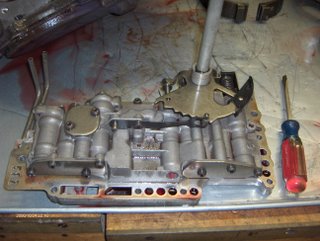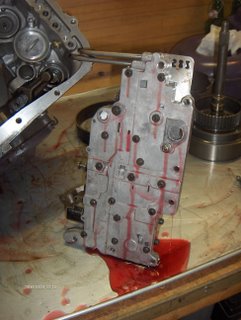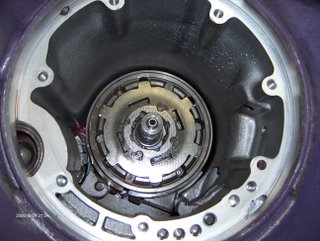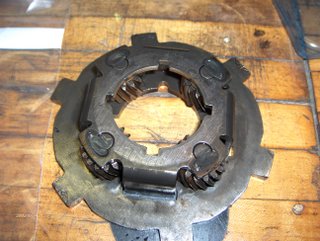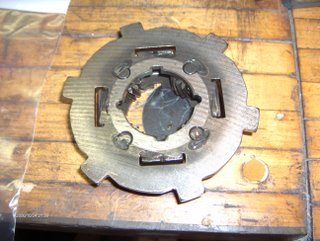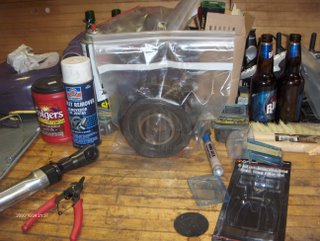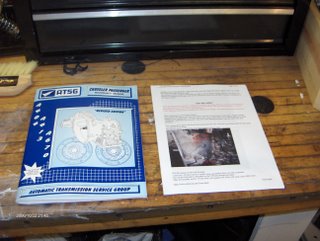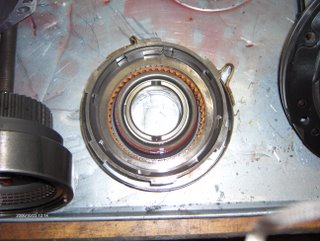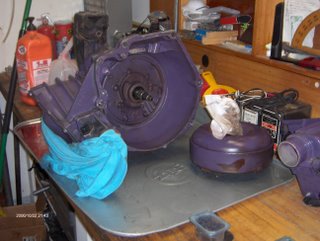The Acclaim Cometh
25 October 2006
A413 trans rebuild part 3 - more main driveline disassembly and some broken stuff
Last night's adventure into Home Transmission Repair(TM) brought us to a crossroads of sorts: do we replace the low overrun clutch cam or not?
Perhaps a picture will help:
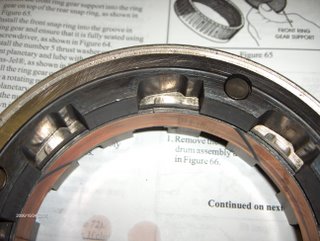 If you click on the photo to zoom in, you'll see where in the places where the rollers and springs go, there are grooves worn into the machined surface. I don't think I'd be able to accurately measure the depth of the grooves given the micrometer I have, but they're definitely deep enough to catch a fingernail on.
If you click on the photo to zoom in, you'll see where in the places where the rollers and springs go, there are grooves worn into the machined surface. I don't think I'd be able to accurately measure the depth of the grooves given the micrometer I have, but they're definitely deep enough to catch a fingernail on.
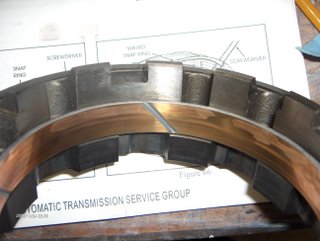 In this shot, we're looking at the low overrun clutch cam from the opposite direction. Notice the slight discoloration in the brass-colored material in the band in the center. If this discoloration was the only wear I saw, I wouldn't condemn the part.
In this shot, we're looking at the low overrun clutch cam from the opposite direction. Notice the slight discoloration in the brass-colored material in the band in the center. If this discoloration was the only wear I saw, I wouldn't condemn the part.
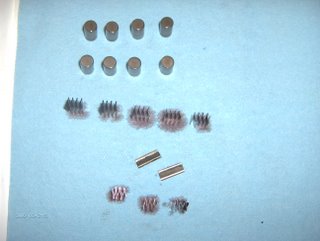 This is the collection of rollers and springs I got out of this thing. There are supposed to be 8 rollers and 8 springs. I found all of the rollers, but I didn't find a complete set of springs. With the way this assembly came apart, there's a remote chance that some of the springs ended up in the differential section of the trans; I haven't gotten there yet. But notice the broken springs I did find....I find it difficult to believe that these just broke as I was taking things apart -- it's possible, I guess -- but I rather doubt it. So I'm thinking that the wear pattern on the overrun clutch plus the broken spring pieces = time for a new low overrun clutch cam.
This is the collection of rollers and springs I got out of this thing. There are supposed to be 8 rollers and 8 springs. I found all of the rollers, but I didn't find a complete set of springs. With the way this assembly came apart, there's a remote chance that some of the springs ended up in the differential section of the trans; I haven't gotten there yet. But notice the broken springs I did find....I find it difficult to believe that these just broke as I was taking things apart -- it's possible, I guess -- but I rather doubt it. So I'm thinking that the wear pattern on the overrun clutch plus the broken spring pieces = time for a new low overrun clutch cam.
I've talked on the phone with my friendly local transmission parts supply house, and there's a guy there with an experienced eye who will take a look for me and tell me if it needs to be swapped.
(Update: I took the part down to the shop and let the guy take a look. I also talked to another supply house about what I was looking at. Both said that 'nobody ever replaces those' -- they just put new springs and rollers in and run 'em. This might be a testament to the poor quality of local rebuilders, or it just might be a fact of life that this isn't something that gets replaced unless it's utterly destroyed, in which case the rest of the trans is beyond repair. The bottom line is that the part is only available used anyway, and the overrunning clutch did not appear to be the source of my tranny's problems, and somebody who looks at this stuff every day said it looked okay to him. Much as I want perfection, I guess I'm going to have to settle for less.)
I'm definitely going to replace the rollers and springs, of course. They're pretty cheap, fortunately -- $6 for the complete set.
****
And now for my front planetary disassembly:
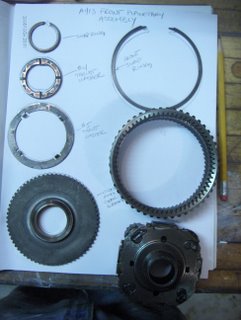 As you might be able to tell, I'm working overtime in the documentation department, laying out which part is which. After I cleaned these parts I laid them out on the sheet of paper, traced them, and then labeled the tracings. I know I'm getting the parts clean -- the sheet of paper serves as a white glove test and there's nary a mark of dirt or oil on it. After I cleaned up the parts from this assembly, I bagged them in a gallon-sized zip lock bag, with the sheet of paper folded up inside for future reference. Overkill? Maybe for experienced trans techs. As for me, it's serving to help me remember the names of the parts, what they go with, etc.
As you might be able to tell, I'm working overtime in the documentation department, laying out which part is which. After I cleaned these parts I laid them out on the sheet of paper, traced them, and then labeled the tracings. I know I'm getting the parts clean -- the sheet of paper serves as a white glove test and there's nary a mark of dirt or oil on it. After I cleaned up the parts from this assembly, I bagged them in a gallon-sized zip lock bag, with the sheet of paper folded up inside for future reference. Overkill? Maybe for experienced trans techs. As for me, it's serving to help me remember the names of the parts, what they go with, etc.
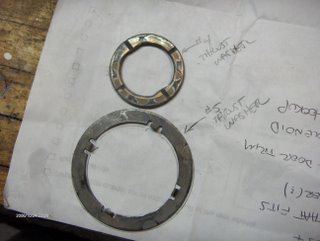
You'll see that there are signs of wear in this closeup on the #4 and #5 thrust washers. It's similar to the wear I've found on almost all of the metal thrust washers, indicating a well-worn transmission in general. The "flat" thrust washers -- not sure what material they're made of, but it appears to be some type of fiber -- all seem to be in good shape with no visible indication of wear. In my inexperience, I would have thought that thrust washers would be part of the "master" rebuild kit I purchased, but it turns out that they're not. Hopefully I can get a kit that replaces all of the thrust washers, or at least the metal ones.
****
Just for reference's sake, here are a couple of shots of the valve body. Note that this thing has been drained and disassembled for three or four days at this point and it's still full of fluid. Ever wonder why it's so hard to drain the transmission completely? This is why!
****
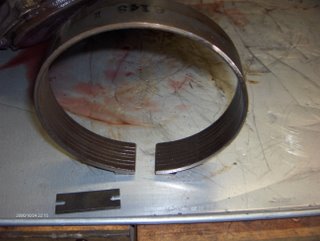 This is the low/reverse band and strut. The band doesn't have any obvious signs of wear on it; I've already got the heavy-duty Sonnax-brand strut replacement ready to go when I reassemble.
This is the low/reverse band and strut. The band doesn't have any obvious signs of wear on it; I've already got the heavy-duty Sonnax-brand strut replacement ready to go when I reassemble.
****
Rear planetary carrier assembly:
...and front and back views. I don't see any signs of wear; I'm just going to clean it up and reuse it as-is. It's tack-welded together, so there's no easy disassembly/planetary gear replacement in the picture anyway. I don't see any broken or cracked gear teeth (I've looked them over as carefully as I can) and nothing seems excessively sloppy. (Trans parts guy: "no gear whine? You're cool with what you have.")
****
Here's a few pics of the rear drum.
****
Thrust washers? Yep, I've got 'em....
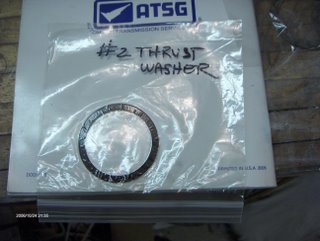
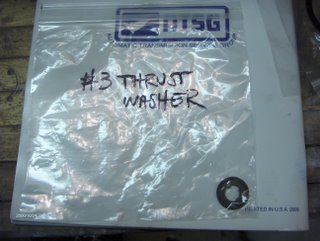

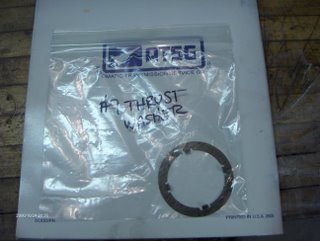
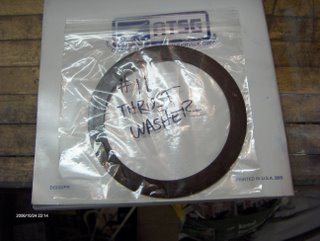
I was considering just replacing the metal ones that have obvious signs of wear on them. Again, as I discussed this on the phone and in person with the trans parts guy, the condition of these does not necessarily indicate replacement is necessary. Regardless, I wanted to replace at least the metal ones....
...but they didn't have one of the washers individually without breaking into a set. They were absolutely willing to do that, but I took this as a sign and bought the whole set. For $17, it's hard to go too far wrong.
***
General notes:
I'm taking the MML's advice and bagging components both before and after I clean them.
Perhaps a picture will help:
 If you click on the photo to zoom in, you'll see where in the places where the rollers and springs go, there are grooves worn into the machined surface. I don't think I'd be able to accurately measure the depth of the grooves given the micrometer I have, but they're definitely deep enough to catch a fingernail on.
If you click on the photo to zoom in, you'll see where in the places where the rollers and springs go, there are grooves worn into the machined surface. I don't think I'd be able to accurately measure the depth of the grooves given the micrometer I have, but they're definitely deep enough to catch a fingernail on. In this shot, we're looking at the low overrun clutch cam from the opposite direction. Notice the slight discoloration in the brass-colored material in the band in the center. If this discoloration was the only wear I saw, I wouldn't condemn the part.
In this shot, we're looking at the low overrun clutch cam from the opposite direction. Notice the slight discoloration in the brass-colored material in the band in the center. If this discoloration was the only wear I saw, I wouldn't condemn the part. This is the collection of rollers and springs I got out of this thing. There are supposed to be 8 rollers and 8 springs. I found all of the rollers, but I didn't find a complete set of springs. With the way this assembly came apart, there's a remote chance that some of the springs ended up in the differential section of the trans; I haven't gotten there yet. But notice the broken springs I did find....I find it difficult to believe that these just broke as I was taking things apart -- it's possible, I guess -- but I rather doubt it. So I'm thinking that the wear pattern on the overrun clutch plus the broken spring pieces = time for a new low overrun clutch cam.
This is the collection of rollers and springs I got out of this thing. There are supposed to be 8 rollers and 8 springs. I found all of the rollers, but I didn't find a complete set of springs. With the way this assembly came apart, there's a remote chance that some of the springs ended up in the differential section of the trans; I haven't gotten there yet. But notice the broken springs I did find....I find it difficult to believe that these just broke as I was taking things apart -- it's possible, I guess -- but I rather doubt it. So I'm thinking that the wear pattern on the overrun clutch plus the broken spring pieces = time for a new low overrun clutch cam.I've talked on the phone with my friendly local transmission parts supply house, and there's a guy there with an experienced eye who will take a look for me and tell me if it needs to be swapped.
(Update: I took the part down to the shop and let the guy take a look. I also talked to another supply house about what I was looking at. Both said that 'nobody ever replaces those' -- they just put new springs and rollers in and run 'em. This might be a testament to the poor quality of local rebuilders, or it just might be a fact of life that this isn't something that gets replaced unless it's utterly destroyed, in which case the rest of the trans is beyond repair. The bottom line is that the part is only available used anyway, and the overrunning clutch did not appear to be the source of my tranny's problems, and somebody who looks at this stuff every day said it looked okay to him. Much as I want perfection, I guess I'm going to have to settle for less.)
I'm definitely going to replace the rollers and springs, of course. They're pretty cheap, fortunately -- $6 for the complete set.
****
And now for my front planetary disassembly:
 As you might be able to tell, I'm working overtime in the documentation department, laying out which part is which. After I cleaned these parts I laid them out on the sheet of paper, traced them, and then labeled the tracings. I know I'm getting the parts clean -- the sheet of paper serves as a white glove test and there's nary a mark of dirt or oil on it. After I cleaned up the parts from this assembly, I bagged them in a gallon-sized zip lock bag, with the sheet of paper folded up inside for future reference. Overkill? Maybe for experienced trans techs. As for me, it's serving to help me remember the names of the parts, what they go with, etc.
As you might be able to tell, I'm working overtime in the documentation department, laying out which part is which. After I cleaned these parts I laid them out on the sheet of paper, traced them, and then labeled the tracings. I know I'm getting the parts clean -- the sheet of paper serves as a white glove test and there's nary a mark of dirt or oil on it. After I cleaned up the parts from this assembly, I bagged them in a gallon-sized zip lock bag, with the sheet of paper folded up inside for future reference. Overkill? Maybe for experienced trans techs. As for me, it's serving to help me remember the names of the parts, what they go with, etc.
You'll see that there are signs of wear in this closeup on the #4 and #5 thrust washers. It's similar to the wear I've found on almost all of the metal thrust washers, indicating a well-worn transmission in general. The "flat" thrust washers -- not sure what material they're made of, but it appears to be some type of fiber -- all seem to be in good shape with no visible indication of wear. In my inexperience, I would have thought that thrust washers would be part of the "master" rebuild kit I purchased, but it turns out that they're not. Hopefully I can get a kit that replaces all of the thrust washers, or at least the metal ones.
****
Just for reference's sake, here are a couple of shots of the valve body. Note that this thing has been drained and disassembled for three or four days at this point and it's still full of fluid. Ever wonder why it's so hard to drain the transmission completely? This is why!
****
 This is the low/reverse band and strut. The band doesn't have any obvious signs of wear on it; I've already got the heavy-duty Sonnax-brand strut replacement ready to go when I reassemble.
This is the low/reverse band and strut. The band doesn't have any obvious signs of wear on it; I've already got the heavy-duty Sonnax-brand strut replacement ready to go when I reassemble.****
Rear planetary carrier assembly:
...and front and back views. I don't see any signs of wear; I'm just going to clean it up and reuse it as-is. It's tack-welded together, so there's no easy disassembly/planetary gear replacement in the picture anyway. I don't see any broken or cracked gear teeth (I've looked them over as carefully as I can) and nothing seems excessively sloppy. (Trans parts guy: "no gear whine? You're cool with what you have.")
****
Here's a few pics of the rear drum.
****
Thrust washers? Yep, I've got 'em....





I was considering just replacing the metal ones that have obvious signs of wear on them. Again, as I discussed this on the phone and in person with the trans parts guy, the condition of these does not necessarily indicate replacement is necessary. Regardless, I wanted to replace at least the metal ones....
...but they didn't have one of the washers individually without breaking into a set. They were absolutely willing to do that, but I took this as a sign and bought the whole set. For $17, it's hard to go too far wrong.
***
General notes:
I'm taking the MML's advice and bagging components both before and after I clean them.
The idea is to keep things together, and also to keep cleaned components dust and lint-free. Use gallon-sized ziplock bags; all but the largest components will fit inside. I'm also using sandwich-sized bags for the thrust washers, and a Sharpie marker to label them. The Sharpie's ink doesn't just wipe off the plastic. Note the blue-labeled bottles of 'mechanic solvent' are used after the evening's transmission rebuilding session is over with...I've got a hard enough time keeping this stuff straight sober...
****
Next up is more cleanup of the assemblies shown so far. Once I've gotten that done, then it's on to the differential section of the trans. I bought the "bat wings" -- the differential pin retainer kit that Chrysler came up with to prevent the pin from walking out and destroying the transmission case. It may be a few days before I get working on this again...Halloween's coming, and the kids need a pumpkin!
****
Next up is more cleanup of the assemblies shown so far. Once I've gotten that done, then it's on to the differential section of the trans. I bought the "bat wings" -- the differential pin retainer kit that Chrysler came up with to prevent the pin from walking out and destroying the transmission case. It may be a few days before I get working on this again...Halloween's coming, and the kids need a pumpkin!
23 October 2006
A413 trans rebuild part 2 - beginning of main driveline disassembly
Sunday night I started disassembling the transmission in preparation for the overhaul. I already have the parts kit including all of the seals, as well as a heavy-duty replacement reverse-band strut and a complete set of replacement clutches and steels. I spent $86 on that stuff, tax included at a local transmission supply house; the ATSG manual cost me $12 on Ebay. The little reverse band strut cost $9 by itself; a fairly expensive little chunk of steel.
The ATSG manual is a big help; I also am indebted to Paul E. Smith, who has posted some rebuild information here, it isn't quite enough to go on by itself, but it does add some photos that the ATSG book doesn't have.
My goal here is to document this in pictures as much as I can...mostly so I can figure out how it all goes back together later! I also hope that maybe some of this stuff will be helpful to somebody else like me who's doing their first trans rebuild. So on to the pictures....
Ya gotta have good reference material before taking something like this on. Pictured on the left is the $12 ATSG service manual for the A413 series. It's pretty much a copy of the factory shop manual, but it also has updated information that your particular model year's shop manual won't have -- improved replacement parts and such. It's a worthwhile investment, even if you have the FSM. On the right is a print-out of the web page mentioned above.
 My little contribution to do-it-yourself home automatic transmission repair: notice the trans is sitting on top of one of those cheap oil drip pans you can get for under $10 at most any parts store. It's like a giant cookie sheet, and the raised lip around the edge will contain a LOT of liquid. It's impossible to completely drain the trans while it's on the car, so you need to be prepared to manage the mess ahead of time. Note the empty milk jug with the turkey baster sticking out of it -- I suctioned up the fluid from the pan and squirted it into the jug. I value my life highly, so I got my own turkey baster instead of using one from the kitchen. Finally, you'll see the roll of shop towels -- this is what has been recommended to me in using to clean the internal parts, as they're lint-free and disposable. Available at Autozone for $2 a roll.
My little contribution to do-it-yourself home automatic transmission repair: notice the trans is sitting on top of one of those cheap oil drip pans you can get for under $10 at most any parts store. It's like a giant cookie sheet, and the raised lip around the edge will contain a LOT of liquid. It's impossible to completely drain the trans while it's on the car, so you need to be prepared to manage the mess ahead of time. Note the empty milk jug with the turkey baster sticking out of it -- I suctioned up the fluid from the pan and squirted it into the jug. I value my life highly, so I got my own turkey baster instead of using one from the kitchen. Finally, you'll see the roll of shop towels -- this is what has been recommended to me in using to clean the internal parts, as they're lint-free and disposable. Available at Autozone for $2 a roll.
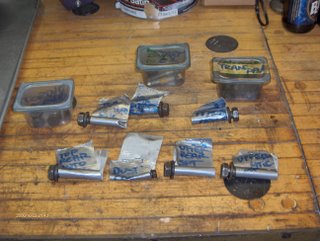 Organization: I know a few people who could take something as complicated as a transmission apart, throw all the pieces into a box, and then have no trouble figuring out where everything goes afterward. I am not that smart, and although I'm just as tempted as the next guy to take shortcuts, I figured out awhile back that such shortcuts usually end up taking me four times as long in the final consideration. So I label stuff, and try to keep my work area as neat as possible. I put each wrench back as soon as I'm done using it. I know, I know. I'm anal.
Organization: I know a few people who could take something as complicated as a transmission apart, throw all the pieces into a box, and then have no trouble figuring out where everything goes afterward. I am not that smart, and although I'm just as tempted as the next guy to take shortcuts, I figured out awhile back that such shortcuts usually end up taking me four times as long in the final consideration. So I label stuff, and try to keep my work area as neat as possible. I put each wrench back as soon as I'm done using it. I know, I know. I'm anal.
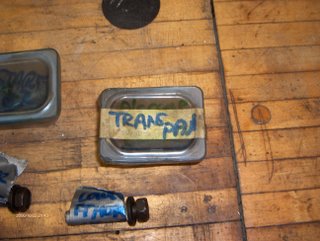 These little containers are great for this kind of work. They started marketing baby fruit in them shortly after Joshua was born, and fortunately I hung onto a bunch of them. I used the same ones back when I tore the Intrepid's engine apart, and they're reusable over and over again. I'm not saying you should just go up to any woman with a baby and ask her if she has any of these...but you know, sometimes the oddest things have been known to work!
These little containers are great for this kind of work. They started marketing baby fruit in them shortly after Joshua was born, and fortunately I hung onto a bunch of them. I used the same ones back when I tore the Intrepid's engine apart, and they're reusable over and over again. I'm not saying you should just go up to any woman with a baby and ask her if she has any of these...but you know, sometimes the oddest things have been known to work!
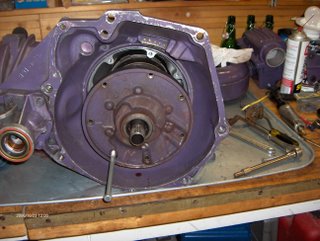 Pulling the front pump. I struggled with this for 45 minutes, even after reading that it should just pop right out, more or less, by using a couple of long bolts threaded into the bolt holes that secure the pump to the transmission body. Well, the ATSG manual isn't a lot of help on this -- they suggest you "attach slide hammers" -- and the other guy's website does mention that there are two threaded bolt holes in the pump, but I guess I'm dense or something. It turns out that two, and only two, of the pump bolt holes have threads that are in the pump body! All the bolt holes have threads, of course, but all except for two have them behind the pump body in the transmission case itself. I couldn't break that thing loose to save my life....duh! Now I'll be chasing the threads in the trans case a 'lil bit to undo some minor damage.
Pulling the front pump. I struggled with this for 45 minutes, even after reading that it should just pop right out, more or less, by using a couple of long bolts threaded into the bolt holes that secure the pump to the transmission body. Well, the ATSG manual isn't a lot of help on this -- they suggest you "attach slide hammers" -- and the other guy's website does mention that there are two threaded bolt holes in the pump, but I guess I'm dense or something. It turns out that two, and only two, of the pump bolt holes have threads that are in the pump body! All the bolt holes have threads, of course, but all except for two have them behind the pump body in the transmission case itself. I couldn't break that thing loose to save my life....duh! Now I'll be chasing the threads in the trans case a 'lil bit to undo some minor damage.
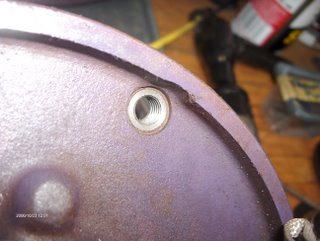 Here's a close shot of one of the front pump bolt holes that is threaded. You'll notice that only two of them are like this. A 3/8ths dia. bolt screws right in. Get one that's at least 6" long, and you can just pry the pump out of the case with a hammer like the other web site suggests. It really does come out easily when you're doing it right.
Here's a close shot of one of the front pump bolt holes that is threaded. You'll notice that only two of them are like this. A 3/8ths dia. bolt screws right in. Get one that's at least 6" long, and you can just pry the pump out of the case with a hammer like the other web site suggests. It really does come out easily when you're doing it right.
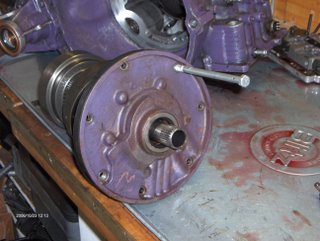 Another image of the front pump -- this time out of the transmission -- with the bolt I used to extract it.
Another image of the front pump -- this time out of the transmission -- with the bolt I used to extract it.
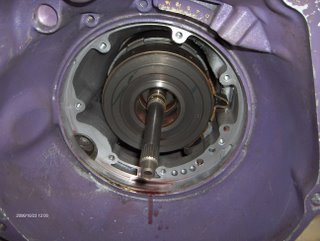 This is what lurks inside of the transmission behind the front pump -- the front (reverse) clutch assembly. You can't see it, but I've got the band adjustment cranked down as tight as it will go to keep everything together while I pulled the cover off, just as the ATSG book recommends.
This is what lurks inside of the transmission behind the front pump -- the front (reverse) clutch assembly. You can't see it, but I've got the band adjustment cranked down as tight as it will go to keep everything together while I pulled the cover off, just as the ATSG book recommends.
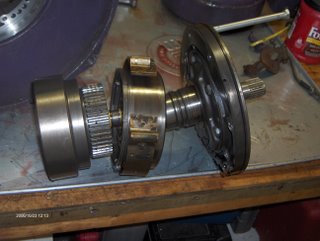 Here's a shot of the front pump, the front clutch assembly, the main shaft, and the rear clutch drum all lined up roughly the same way they are found inside the transmission.
Here's a shot of the front pump, the front clutch assembly, the main shaft, and the rear clutch drum all lined up roughly the same way they are found inside the transmission.
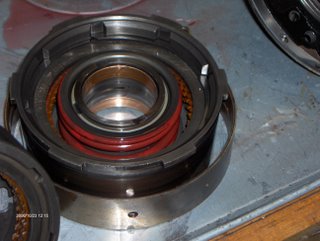 This is a pair of detail shots of the front clutch drum assembly, again, remember I'm trying to document how things go together for myself.
This is a pair of detail shots of the front clutch drum assembly, again, remember I'm trying to document how things go together for myself.
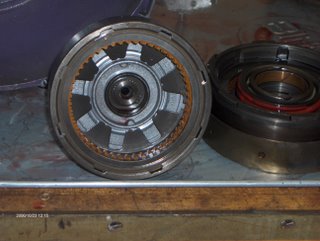
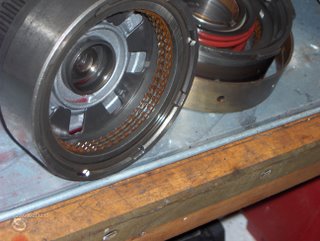 This is a pair of detail shots of the rear clutch drum assembly. Hopefully I'm catching everything in the pictures I might need when I go to reassemble.
This is a pair of detail shots of the rear clutch drum assembly. Hopefully I'm catching everything in the pictures I might need when I go to reassemble.
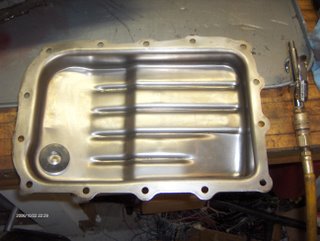 I've been told that you have to have stuff immaculately clean in order for a trans overhaul to be a success instead of a time bomb. So I went nuts cleaning the RTV residue off of the trans pan, first using a razorblade scraper, and then finishing up with some coarse steel wool along with a little Gumout as a solvent. I noticed that although the steel wool does a good job of cleaning things up, it also leaves little fine bits of wire all over the place, which I played hell cleaning up. Damn, that pan is shiny, though.
I've been told that you have to have stuff immaculately clean in order for a trans overhaul to be a success instead of a time bomb. So I went nuts cleaning the RTV residue off of the trans pan, first using a razorblade scraper, and then finishing up with some coarse steel wool along with a little Gumout as a solvent. I noticed that although the steel wool does a good job of cleaning things up, it also leaves little fine bits of wire all over the place, which I played hell cleaning up. Damn, that pan is shiny, though.
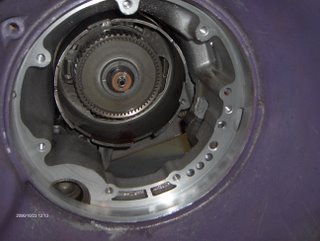 Finally, here's a picture of where I'll pick up next time -- this is a shot into the case of the transmission showing the #3 thrust washer. That comes out next.
Finally, here's a picture of where I'll pick up next time -- this is a shot into the case of the transmission showing the #3 thrust washer. That comes out next.
The ATSG manual is a big help; I also am indebted to Paul E. Smith, who has posted some rebuild information here, it isn't quite enough to go on by itself, but it does add some photos that the ATSG book doesn't have.
My goal here is to document this in pictures as much as I can...mostly so I can figure out how it all goes back together later! I also hope that maybe some of this stuff will be helpful to somebody else like me who's doing their first trans rebuild. So on to the pictures....
Ya gotta have good reference material before taking something like this on. Pictured on the left is the $12 ATSG service manual for the A413 series. It's pretty much a copy of the factory shop manual, but it also has updated information that your particular model year's shop manual won't have -- improved replacement parts and such. It's a worthwhile investment, even if you have the FSM. On the right is a print-out of the web page mentioned above.
 My little contribution to do-it-yourself home automatic transmission repair: notice the trans is sitting on top of one of those cheap oil drip pans you can get for under $10 at most any parts store. It's like a giant cookie sheet, and the raised lip around the edge will contain a LOT of liquid. It's impossible to completely drain the trans while it's on the car, so you need to be prepared to manage the mess ahead of time. Note the empty milk jug with the turkey baster sticking out of it -- I suctioned up the fluid from the pan and squirted it into the jug. I value my life highly, so I got my own turkey baster instead of using one from the kitchen. Finally, you'll see the roll of shop towels -- this is what has been recommended to me in using to clean the internal parts, as they're lint-free and disposable. Available at Autozone for $2 a roll.
My little contribution to do-it-yourself home automatic transmission repair: notice the trans is sitting on top of one of those cheap oil drip pans you can get for under $10 at most any parts store. It's like a giant cookie sheet, and the raised lip around the edge will contain a LOT of liquid. It's impossible to completely drain the trans while it's on the car, so you need to be prepared to manage the mess ahead of time. Note the empty milk jug with the turkey baster sticking out of it -- I suctioned up the fluid from the pan and squirted it into the jug. I value my life highly, so I got my own turkey baster instead of using one from the kitchen. Finally, you'll see the roll of shop towels -- this is what has been recommended to me in using to clean the internal parts, as they're lint-free and disposable. Available at Autozone for $2 a roll. Organization: I know a few people who could take something as complicated as a transmission apart, throw all the pieces into a box, and then have no trouble figuring out where everything goes afterward. I am not that smart, and although I'm just as tempted as the next guy to take shortcuts, I figured out awhile back that such shortcuts usually end up taking me four times as long in the final consideration. So I label stuff, and try to keep my work area as neat as possible. I put each wrench back as soon as I'm done using it. I know, I know. I'm anal.
Organization: I know a few people who could take something as complicated as a transmission apart, throw all the pieces into a box, and then have no trouble figuring out where everything goes afterward. I am not that smart, and although I'm just as tempted as the next guy to take shortcuts, I figured out awhile back that such shortcuts usually end up taking me four times as long in the final consideration. So I label stuff, and try to keep my work area as neat as possible. I put each wrench back as soon as I'm done using it. I know, I know. I'm anal. These little containers are great for this kind of work. They started marketing baby fruit in them shortly after Joshua was born, and fortunately I hung onto a bunch of them. I used the same ones back when I tore the Intrepid's engine apart, and they're reusable over and over again. I'm not saying you should just go up to any woman with a baby and ask her if she has any of these...but you know, sometimes the oddest things have been known to work!
These little containers are great for this kind of work. They started marketing baby fruit in them shortly after Joshua was born, and fortunately I hung onto a bunch of them. I used the same ones back when I tore the Intrepid's engine apart, and they're reusable over and over again. I'm not saying you should just go up to any woman with a baby and ask her if she has any of these...but you know, sometimes the oddest things have been known to work! Pulling the front pump. I struggled with this for 45 minutes, even after reading that it should just pop right out, more or less, by using a couple of long bolts threaded into the bolt holes that secure the pump to the transmission body. Well, the ATSG manual isn't a lot of help on this -- they suggest you "attach slide hammers" -- and the other guy's website does mention that there are two threaded bolt holes in the pump, but I guess I'm dense or something. It turns out that two, and only two, of the pump bolt holes have threads that are in the pump body! All the bolt holes have threads, of course, but all except for two have them behind the pump body in the transmission case itself. I couldn't break that thing loose to save my life....duh! Now I'll be chasing the threads in the trans case a 'lil bit to undo some minor damage.
Pulling the front pump. I struggled with this for 45 minutes, even after reading that it should just pop right out, more or less, by using a couple of long bolts threaded into the bolt holes that secure the pump to the transmission body. Well, the ATSG manual isn't a lot of help on this -- they suggest you "attach slide hammers" -- and the other guy's website does mention that there are two threaded bolt holes in the pump, but I guess I'm dense or something. It turns out that two, and only two, of the pump bolt holes have threads that are in the pump body! All the bolt holes have threads, of course, but all except for two have them behind the pump body in the transmission case itself. I couldn't break that thing loose to save my life....duh! Now I'll be chasing the threads in the trans case a 'lil bit to undo some minor damage. Here's a close shot of one of the front pump bolt holes that is threaded. You'll notice that only two of them are like this. A 3/8ths dia. bolt screws right in. Get one that's at least 6" long, and you can just pry the pump out of the case with a hammer like the other web site suggests. It really does come out easily when you're doing it right.
Here's a close shot of one of the front pump bolt holes that is threaded. You'll notice that only two of them are like this. A 3/8ths dia. bolt screws right in. Get one that's at least 6" long, and you can just pry the pump out of the case with a hammer like the other web site suggests. It really does come out easily when you're doing it right. Another image of the front pump -- this time out of the transmission -- with the bolt I used to extract it.
Another image of the front pump -- this time out of the transmission -- with the bolt I used to extract it. This is what lurks inside of the transmission behind the front pump -- the front (reverse) clutch assembly. You can't see it, but I've got the band adjustment cranked down as tight as it will go to keep everything together while I pulled the cover off, just as the ATSG book recommends.
This is what lurks inside of the transmission behind the front pump -- the front (reverse) clutch assembly. You can't see it, but I've got the band adjustment cranked down as tight as it will go to keep everything together while I pulled the cover off, just as the ATSG book recommends. Here's a shot of the front pump, the front clutch assembly, the main shaft, and the rear clutch drum all lined up roughly the same way they are found inside the transmission.
Here's a shot of the front pump, the front clutch assembly, the main shaft, and the rear clutch drum all lined up roughly the same way they are found inside the transmission. This is a pair of detail shots of the front clutch drum assembly, again, remember I'm trying to document how things go together for myself.
This is a pair of detail shots of the front clutch drum assembly, again, remember I'm trying to document how things go together for myself.
 This is a pair of detail shots of the rear clutch drum assembly. Hopefully I'm catching everything in the pictures I might need when I go to reassemble.
This is a pair of detail shots of the rear clutch drum assembly. Hopefully I'm catching everything in the pictures I might need when I go to reassemble. I've been told that you have to have stuff immaculately clean in order for a trans overhaul to be a success instead of a time bomb. So I went nuts cleaning the RTV residue off of the trans pan, first using a razorblade scraper, and then finishing up with some coarse steel wool along with a little Gumout as a solvent. I noticed that although the steel wool does a good job of cleaning things up, it also leaves little fine bits of wire all over the place, which I played hell cleaning up. Damn, that pan is shiny, though.
I've been told that you have to have stuff immaculately clean in order for a trans overhaul to be a success instead of a time bomb. So I went nuts cleaning the RTV residue off of the trans pan, first using a razorblade scraper, and then finishing up with some coarse steel wool along with a little Gumout as a solvent. I noticed that although the steel wool does a good job of cleaning things up, it also leaves little fine bits of wire all over the place, which I played hell cleaning up. Damn, that pan is shiny, though. Finally, here's a picture of where I'll pick up next time -- this is a shot into the case of the transmission showing the #3 thrust washer. That comes out next.
Finally, here's a picture of where I'll pick up next time -- this is a shot into the case of the transmission showing the #3 thrust washer. That comes out next.
A413 trans rebuild part 1 - removal
Saturday, after a very long delay waiting for funds and time, I finally tore the transmission back out of the Acclaim in order to rebuild it. It turned out that the no-upshift issue I mentioned back in May was really a failed seal in the transmission. After a lot of playing around with the valve body, I finally broke down and obtained a gauge and did a diagnosis using the line pressure test ports on the front of the unit, and realized that pressure dropped to zero almost as soon as I would put it into gear. So this past summer was spent on other projects while I did research and gathered opinions about what I might do.
Finally I got things back underway, though and yanked it out on Saturday. Some thoughts on removing this trans:
Finally I got things back underway, though and yanked it out on Saturday. Some thoughts on removing this trans:
- First and foremost, a lot of people mention what a bitch it is to get the 15mm bolt out that secures the starter through the engine block to the transmission. I literally spent a few minutes looking for "the difficult bolt" after I already had this one out. True, you cannot get a traditional socket and ratchet on it, however it's a piece of cake with a 15mm ratcheting box-end wrench. I already had pulled the axle shafts before I got around to loosening this one. This is one of those cases where having the right tool for the job pays off handsomely. I had the thing out in under a minute, and I understand some people have taken hours and hours to do this.
- Removing the flex-plate to torque-converter bolts: there are four of these, and first you have to remove the sheetmetal access cover, which involves backing out two 18mm bolts -- one through the front engine mount, the other just between the engine block and the transmission in the rear (firewall side) of the drivetrain. Then you have to remove the 10mm bolt that is in the center of the access plate. I then struggled for a bit trying to get the plate to come loose -- I hadn't loosened any of the other engine-to-trans bolts yet. I hammered it out using a long socket extension to catch the edge of the cover from above. You will also need some means of locking the crankshaft into place while you loosen the torque converter bolts themselves. I used my good old fashioned crowbar wedged between the flexplate and the bottom of the bellhousing. It doesn't take much pressure to hold things in place. Finally, you will need to rotate the engine 90 degrees at least three times to bring each bolt around to where you can reach it. I used a 13mm socket on a long extension to the center of the crank pulley and my 3/8ths ratchet. Works great when all of the sparkplugs are removed.
- I tossed 'round the idea of just pulling the entire engine/trans as an assembly. In the end, I think just dropping the trans out the bottom using an engine crane is less work. I have the car supported on jack stands with 20" of clearance between the floor and the bottom of the radiator support. This proved to be more than enough room to easily slide the trans out. I'm still a relative newbie, but working with air tools by myself I had the trans drained and sitting on my workbench 3 hours after I started raising the car. Not bad...
- An engine crane or cherry picker. I got mine used for $60 -- I think they're around $140 new at places like Harbor Freight. If the roof in your garage has exposed rafters, you might get by with a come-along, although I'm sure glad I don't have to do it that way. For one thing, you'd probably have to remove the hood to use a come-along, while the engine crane will just sneak right in under the hood. After I got the transmission out, I backed up the crane a few inches and attached the chain to the main ground point on the driver's side of the cylinder head to support the engine--which hung in there just fine on the two remaining engine mounts while I removed the trans. I don't think you need to have any special support for the engine while removing the trans-- for a short term, it apparently is well enough supported on the front and passenger side mounts that it isn't going anywhere.
- I think the transmission jacks that support the trans from underneath would be a lot more difficult to use. I attached the crane's chain using the bolt-hole on the top of the bellhousing, just to the right and slightly below the timing window. It isn't the largest bolt on the transmission, but it supported it with no sign of strain.
- Get yourself a 15mm ratcheting box-end wrench for that starte bolt!! Check out Sears item #00942596000 Mfr. model #42596, or #00947819000 Mfr. model #9115 -- either one of these will do the job.
- Jack stands. Must have. No excuses.
- I am fortunate enough to have air tools to use, including a pneumatic ratchet and an impact gun. It makes the business of removing some of those big 18mm engine-trans bolts or the 15mm sway-bar bolts a piece of cake. If you don't have this luxury, invest in a good quality 1/2" breaker bar.
- A 'rough service' bulb for my trouble light. I drop my trouble light. A lot. I would've replaced at least three standard lightbulbs after that thing hit the floor just while pulling the trans alone. Worth the $1.99 at Autozone. If buying online, consider http://www.sjdiscounttools.com/slp60016.html
- Have lots of oil dry handy, in case you do what I did, which was not moving the drain pan far enough away from underneath the trans when I actually dropped it down. Yep...most of the fluid I had so carefully drained ended up on the floor anyway. Yuck.
